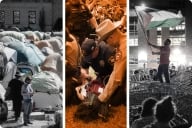You have /5 articles left.
Sign up for a free account or log in.
“History is a nightmare from which I am trying to awake,” says Stephen Dedalus in Ulysses. Ditto, but the more I read and write on it, the deeper I dream.
As I wrote here last month, I only just realized that some in the county I’m originally from tried to secede from the Union. (I heard even more recently that secessionism is alive, though now the sentiment is against the state, not the country.) My recent reading has again taken me through Illinois race riots (many of which had additional causes in labor problems) in East St. Louis, Springfield, Chicago, Virden, Pana, and Carterville (and twenty-six other riots in cities around the country in 1919 alone, including Washington, D.C.; Elaine, Arkansas; Charleston, South Carolina; Knoxville and Nashville, Tennessee; Longview, Texas; and Omaha, Nebraska).
 That’s why it’s such a relief when history’s unknowable weirdness and complexity produces an unexpectedly hopeful narrative, this one from Barbara Burr Hubbs’ Pioneer Folks and Places, and Paula M. Davenport in the Williamson County, Illinois, Sesquicentennial History.
That’s why it’s such a relief when history’s unknowable weirdness and complexity produces an unexpectedly hopeful narrative, this one from Barbara Burr Hubbs’ Pioneer Folks and Places, and Paula M. Davenport in the Williamson County, Illinois, Sesquicentennial History.
It turns out that in the northeast corner of that county there used to be a community of freed slaves called Africa. In 1816, a John McCreery moved from Kentucky to the Illinois Territory, bringing several slaves with him. When Illinois became a state in the union, with an anti-slavery clause in the constitution, McCreery left four slaves behind with his son Robert, and took the rest to his other son’s in Missouri. The ones in Illinois were freed and stayed near the McCreerys. When the old man died in Missouri, he left his slaves to another son, Alexander, who brought them to Illinois too, bought more land, and built homes for them on it. (He also bought the husband of one of his father’s slaves for $300 from a neighbor and brought him north too.)
Another family of slaves, the Stewarts, were brought from Kentucky to freedom and given forty acres. Others came after the Emancipation, or were given military land grants for serving in the Union Army. The community became, at its largest in the late 1800s, home to 150 people of black, white, and Native-American heritage living on 500 acres, where they grew cotton, tobacco, and castor beans.
Davenport’s article suggests the community is gone, but at the time of her writing (1989), descendants of one of the families still owned a retreat there called Willow Bend Farm, and on the third Sunday of May each year other descendants gathered for a barbecue held on the cemetery grounds where their ancestors were buried.





